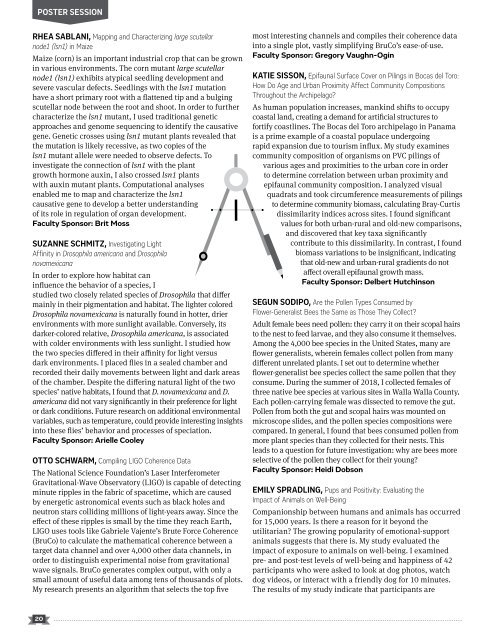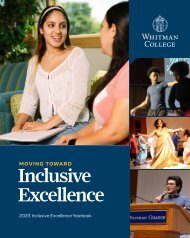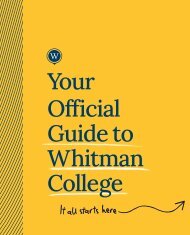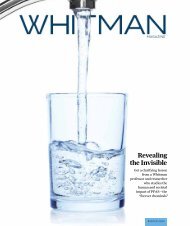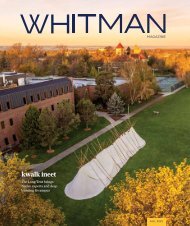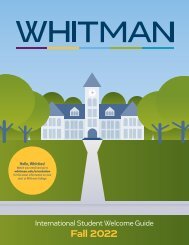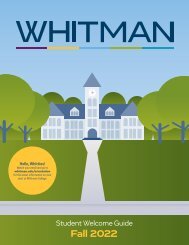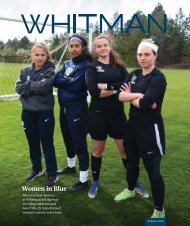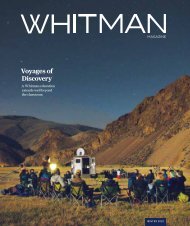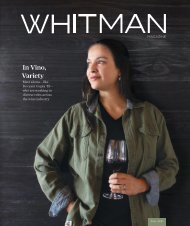You also want an ePaper? Increase the reach of your titles
YUMPU automatically turns print PDFs into web optimized ePapers that Google loves.
POSTER SESSION<br />
RHEA SABLANI, Mapping and Characterizing large scutellar<br />
node1 (lsn1) in Maize<br />
Maize (corn) is an important industrial crop that can be grown<br />
in various environments. The corn mutant large scutellar<br />
node1 (lsn1) exhibits atypical seedling development and<br />
severe vascular defects. Seedlings with the lsn1 mutation<br />
have a short primary root with a flattened tip and a bulging<br />
scutellar node between the root and shoot. In order to further<br />
characterize the lsn1 mutant, I used traditional genetic<br />
approaches and genome sequencing to identify the causative<br />
gene. Genetic crosses using lsn1 mutant plants revealed that<br />
the mutation is likely recessive, as two copies of the<br />
lsn1 mutant allele were needed to observe defects. To<br />
investigate the connection of lsn1 with the plant<br />
growth hormone auxin, I also crossed lsn1 plants<br />
with auxin mutant plants. Computational analyses<br />
enabled me to map and characterize the lsn1<br />
causative gene to develop a better understanding<br />
of its role in regulation of organ development.<br />
Faculty Sponsor: Brit Moss<br />
SUZANNE SCHMITZ, Investigating Light<br />
Affinity in Drosophila americana and Drosophila<br />
novamexicana<br />
In order to explore how habitat can<br />
influence the behavior of a species, I<br />
studied two closely related species of Drosophila that differ<br />
mainly in their pigmentation and habitat. The lighter colored<br />
Drosophila novamexicana is naturally found in hotter, drier<br />
environments with more sunlight available. Conversely, its<br />
darker-colored relative, Drosophila americana, is associated<br />
with colder environments with less sunlight. I studied how<br />
the two species differed in their affinity for light versus<br />
dark environments. I placed flies in a sealed chamber and<br />
recorded their daily movements between light and dark areas<br />
of the chamber. Despite the differing natural light of the two<br />
species’ native habitats, I found that D. novamexicana and D.<br />
americana did not vary significantly in their preference for light<br />
or dark conditions. Future research on additional environmental<br />
variables, such as temperature, could provide interesting insights<br />
into these flies’ behavior and processes of speciation.<br />
Faculty Sponsor: Arielle Cooley<br />
OTTO SCHWARM, Compiling LIGO Coherence Data<br />
The National Science Foundation’s Laser Interferometer<br />
Gravitational-Wave Observatory (LIGO) is capable of detecting<br />
minute ripples in the fabric of spacetime, which are caused<br />
by energetic astronomical events such as black holes and<br />
neutron stars colliding millions of light-years away. Since the<br />
effect of these ripples is small by the time they reach Earth,<br />
LIGO uses tools like Gabriele Vajente’s Brute Force Coherence<br />
(BruCo) to calculate the mathematical coherence between a<br />
target data channel and over 4,000 other data channels, in<br />
order to distinguish experimental noise from gravitational<br />
wave signals. BruCo generates complex output, with only a<br />
small amount of useful data among tens of thousands of plots.<br />
My research presents an algorithm that selects the top five<br />
most interesting channels and compiles their coherence data<br />
into a single plot, vastly simplifying BruCo’s ease-of-use.<br />
Faculty Sponsor: Gregory Vaughn-Ogin<br />
KATIE SISSON, Epifaunal Surface Cover on Pilings in Bocas del Toro:<br />
How Do Age and Urban Proximity Affect Community Compositions<br />
Throughout the Archipelago?<br />
As human population increases, mankind shifts to occupy<br />
coastal land, creating a demand for artificial structures to<br />
fortify coastlines. The Bocas del Toro archipelago in Panama<br />
is a prime example of a coastal populace undergoing<br />
rapid expansion due to tourism influx. My study examines<br />
community composition of organisms on PVC pilings of<br />
various ages and proximities to the urban core in order<br />
to determine correlation between urban proximity and<br />
epifaunal community composition. I analyzed visual<br />
quadrats and took circumference measurements of pilings<br />
to determine community biomass, calculating Bray-Curtis<br />
dissimilarity indices across sites. I found significant<br />
values for both urban-rural and old-new comparisons,<br />
and discovered that key taxa significantly<br />
contribute to this dissimilarity. In contrast, I found<br />
biomass variations to be insignificant, indicating<br />
that old-new and urban-rural gradients do not<br />
affect overall epifaunal growth mass.<br />
Faculty Sponsor: Delbert Hutchinson<br />
SEGUN SODIPO, Are the Pollen Types Consumed by<br />
Flower-Generalist Bees the Same as Those They Collect?<br />
Adult female bees need pollen: they carry it on their scopal hairs<br />
to the nest to feed larvae, and they also consume it themselves.<br />
Among the 4,000 bee species in the United States, many are<br />
flower generalists, wherein females collect pollen from many<br />
different unrelated plants. I set out to determine whether<br />
flower-generalist bee species collect the same pollen that they<br />
consume. During the summer of 2018, I collected females of<br />
three native bee species at various sites in Walla Walla County.<br />
Each pollen-carrying female was dissected to remove the gut.<br />
Pollen from both the gut and scopal hairs was mounted on<br />
microscope slides, and the pollen species compositions were<br />
compared. In general, I found that bees consumed pollen from<br />
more plant species than they collected for their nests. This<br />
leads to a question for future investigation: why are bees more<br />
selective of the pollen they collect for their young?<br />
Faculty Sponsor: Heidi Dobson<br />
EMILY SPRADLING, Pups and Positivity: Evaluating the<br />
Impact of Animals on Well-Being<br />
Companionship between humans and animals has occurred<br />
for 15,000 years. Is there a reason for it beyond the<br />
utilitarian? The growing popularity of emotional-support<br />
animals suggests that there is. My study evaluated the<br />
impact of exposure to animals on well-being. I examined<br />
pre- and post-test levels of well-being and happiness of 42<br />
participants who were asked to look at dog photos, watch<br />
dog videos, or interact with a friendly dog for 10 minutes.<br />
The results of my study indicate that participants are<br />
20


